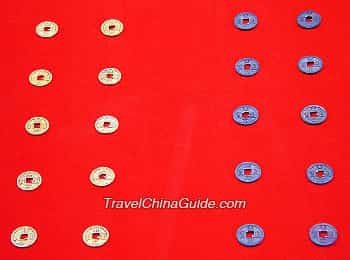Tang Money
Kai Yuan Tong Bao
 |
| Gold and silver coins inscribed with 'Kai Yuan Tong Bao', Tang Dynasty |
Kai Yuan Tong Bao's size, weight and the accordance of name with the form made it not only the main currency of the Tang Dynasty but also the norm of the coin in the next dynasties. It was claimed the most successful money in Chinese history. Since its first mintage, it had been used through out the Tang Dynasty without discontinuity, which was rare in the monetary history. People's preference for it diminished not even the least after Tang Dynasty's collapse. Till Hong Xi'an Tong Bao in 1916, this form of money had experienced nearly 1300 years.
Fei Qian (Flying Money)
| Gold coins inscribed with characters 'Kai Yuan Tong Bao' |
There were two types of fei qian. One was state-owned and the other was private bankers. Special offices were set by the government for transfer and encash. Businessmen could cash in at any time with the paper receipt in any one of the over 40 offices in the country. Unlike the state-owned ones, the private bankers differentiated themselves by the fact they did not charge any fee for encash of fei qian. Their profit came from the interest as a result of slow transportation and time lag of one or two months before a fei qian was finally cashed in.
Melting Buddha Statues for Mintage
During the Five Dynasties, another wise sovereign, Emperor Shi Zong of Later Zhou, commanded to melt Buddha statues for mintage. Many Buddhist believers and even ministers in court were against this order but Emperor Shi Zhong defended himself by saying, "The Buddha is determined to bring happiness to all flesh. If he is alive, he would sacrifice his own life for others, not to mention his statues?" Upon hearing this, the objectors were left speechless but to obey.
- Last updated on Aug. 08, 2022 -
Questions & Answers on Tang Money
Asked by Mr.teh from CHINA | Apr. 24, 2011 02:17 Reply
Reply
i have a kai yuan tong bao ancient gold coin .i have tested and its the real gold.its weight is 7.98gram .it purity is aroung 90%above.how much do it worth nw !!!its is from tang dinasty.
Answers (1)
Answered by Mr.James | Apr. 24, 2011 21:29 2
2 7
7 Reply
Reply
Kai Yuan Tong Bao was used as the currency of the Tang Dynasty for over 300 years, so , there are many such coins, I mean copper ones. The gold ones were not used in money circulation but as bestowed money. If it is real gold and real kai yuan tong bao made in the Tang Dynasty, it costs 80,000 for one coin. This is the reference price. The actual price is according to its condition.
Asked by Mr.teh from CHINA | Apr. 21, 2011 06:59 Reply
Reply
whats the value of the coin of tang dinasty and what the weight of the real coin.
Answers (1)
Answered by Mr.Hank | Apr. 21, 2011 22:32 1
1 5
5 Reply
Reply
The coin of the Tang Dynasty were made of gold, silver, copper and lead. One coin weighed two Zhu which was a basic unit of currency of that time.